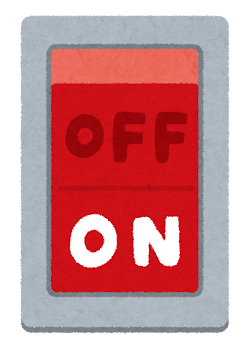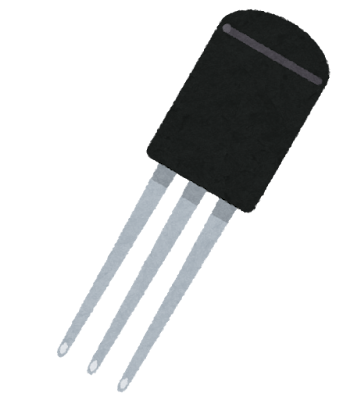The shortage of semiconductors has become a social problem. One of the major reasons for this is that computers are being installed in all kinds of things in the world, and the production of semiconductors, which are the materials used in computers, cannot keep up with the demand.
In this article, we will discuss “What is a computer anyway? and “Why computers need semiconductors?”.

How do computers calculate?
Most of the computers in use today perform various calculations using only "0" and "1". This is based on "The Calculus of Logic" as written by the 19th century British scholar Boole. Boole was the first to prove that any kind of logic can be expressed using two values, "true" and "false," which is also the origin of the term Boolean (as a data type).
en.wikipedia.org/wiki/George_Boole
Computers are a mass of switches
You can do all kinds of calculations with "0" and "1"… A computer is a thing that expresses this with switches "ON" and "OFF".
- When electricity is passed through it: ON
- When no electricity is passed through it: OFF

The evolution of switches
Computers use switches to perform various calculations and processes. So, if the performance of the switch is improved, it will be able to process quickly. If you imagine an abacus, it may be easier to understand. The faster you play the abacus ball, the higher the performance.
The first switch
The first switch was a switch made of electromagnets called a relay. When electricity is passed through an electromagnet, it becomes like a magnet and moves the iron switch. To physically move a switch made of iron, the operation was of course slower.
Then to semiconductors
Later, after the vacuum tube switch, the semiconductor switch was invented. This semiconductor switch is called a "transistor".
What is a semiconductor?
A material that conducts electricity well, such as a metal, is called a conductor. A semiconductor is a material that does not conduct electricity, such as rubber, and a material that conducts electricity well, such as metal. For this reason, they are called "semi" conductors.
Germanium and silicon are semiconductors.
Transistor
A semiconductor switch is called a "transistor". Instead of physically moving the switch, it is turned on and off by the movement of electrons, which makes it much faster and smaller than an electromagnet switch.

Electric current is the flow of electrons in the first place. By controlling the movement of electrons moving around in a semiconductor, it is possible to prevent electricity from flowing or not flowing.
IC (Integrated Circuit) - LSI
Semiconductors have made it possible to make switches smaller. If we could make a computer using many of these, we can make something with better performance. IC (integrated circuit) is a combination of multiple transistors.
By the 1970s, more than 1,000 transistors were incorporated into a single computer, and ICs with this level of integration are called "LSI.
Binary numbers and bits
By the way, in the world of "0" and "1", everything is represented by "0" and "1". If we try to express 1~10 in binary numbers, we get the following.

1~10 in binary numbersIn order to express "10" in decimal, four digits are required in binary. In this way, the larger the number of digits that can be handled at one time, the more information can be processed.
Bit
A single digit is called a "bit," 4 bits for 4 digits, 32 bits for 32 digits. You often hear about 32-bit CPUs or 64-bit CPUs, which indicates how many binary digits the CPU can calculate. The higher the number of digits, the more information can be handled at once.
What is clock frequency?
The "ON" and "OFF" of a switch are switched at regular intervals, rather than unevenly. The signal of this repetition of "ON" and "OFF" is called the "clock", and the number of times it switches "ON" and "OFF" in one second is called the "clock frequency".
For example, if the clock frequency is 1 GHz (1 gigahertz), it will switch a billion times a second. The higher the clock frequency, the faster the computer can perform the process.
Improving computer performance
The more, the faster…?As we have seen, the performance of the switch is directly related to the performance of the computer. The miniaturization of switches, or transistors, continues to evolve year by year, and the number of transistors in a computer continues to increase.
The smaller each transistor becomes, the shorter the distance between the electrons it moves, and the faster it becomes. This is also the reason why transistors have been getting smaller and smaller every year. However, this does not mean that transistors can be made infinitely smaller. This is because the size of a thing cannot be smaller than an atom.
Multi-core
The next step forward from downsizing is "multi-core". This is a technique that allows many CPUs to work together to process multiple tasks simultaneously. Of course, the more cores you have, the more tasks you can perform simultaneously.
Apple M1 Pro chip
At the time of writing, the latest Apple M1 Pro chip contains 33.7 billion (!) transistors. The CPU has 8 or 10 cores, of which 6 or 8 are high performance cores, and the GPU has 14 or 16 cores. As you can see, compared to other chips, the chip itself is larger, with more cores and more semiconductors.
apple.com/newsroom/2021/10/introducing-m1-p..
Summary
Computers use "0" and "1" to perform calculations. 0" and "1" can be represented by electrical switches. Semiconductors are materials for switches that are very small and operate at high speed
And more…
There is a large amount of silicon and other materials, which are often used as semiconductors, in the world. What is in short supply is the production equipment to process them. A "tum-tum computer" has also been developed lately that processes by the sound of guitar instead of "0" and "1".
